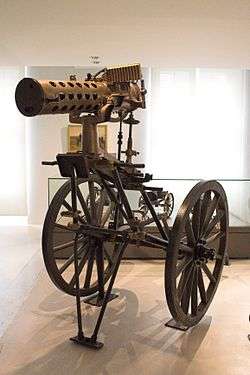Poudre B
Poudre B was the first practical smokeless gunpowder. It was perfected between 1882 and 1884 at "Laboratoire Central des Poudres et Salpêtres" in Paris, France. Originally called "Poudre V", from the name of the inventor, Paul Vieille, it was arbitrarily renamed "Poudre B" (short for poudre blanche -- white powder, as distinguished from black powder) to distract German espionage.[1] "Poudre B" is made from 68.2% insoluble nitrocellulose, 29.8% soluble nitrocellulose gelatinized with ether and 2% paraffin. "Poudre B" is made up of very small paper-thin flakes that are not white but dark greenish grey in color. "Poudre B" was first used to load the 8mm Lebel cartridges issued in 1886 for the Lebel rifle.
History
French chemist Paul Vieille had followed the findings of German-Swiss chemist Christian Friedrich Schonbein, who had created the explosive nitrocellulose or "guncotton" in 1846 by treating cotton fibers with a nitric acid and sulphuric acid mixture. However guncotton, an explosive substance, proved to be too fast burning at the time for direct use in firearms and artillery ammunition. Then Paul Vieille went one step further in 1882-84 and, after many trials and errors, succeeded in transforming guncotton into a colloidal substance by gelatinizing it in an alcohol-ether mixture following which he stabilized it with amyl alcohol. He then used roller presses to transform this gelatinized colloidal substance into extremely thin sheets which, after drying, were cut up into small flakes. This single-base smokeless powder was originally named "Poudre V" after the inventor's name. That denomination was later changed arbitrarily to "Poudre B" in order to distract German espionage. The original "Poudre B" of 1884 was almost immediately replaced by improved "Poudre BF(NT)" in 1888. In 1896 "Poudre BF(NT)" was replaced by "Poudre BF(AM)" which was followed by "Poudre BN3F" in 1901. The latter was stabilized with the antioxidant diphenylamine instead of amyl alcohol and it gave safe and regular performance as the standard French gunpowder used during World War I (1914–1918). It was followed during the 1920s by "Poudre BN3F(Ae)" and later by "Poudre BPF1", which remained in service until the 1960s.
Performance
Three times more powerful than black powder for the same weight, and not generating large quantities of smoke, "Poudre B" gave the user a huge tactical advantage. It was hastily adopted by the French military in 1886, followed by all the major military powers within a few years.
Prior to its introduction, a squad of soldiers firing volleys would be unable to see their targets after a few shots, while their own location would be obvious because of the cloud of smoke hanging over them. The higher power of the new powder gave a higher muzzle velocity, which in turn produced a flatter bullet trajectory and thus a longer range. It also required lesser volumes of gunpowder and allowed a smaller caliber, thus lighter bullets, so a soldier could carry more ammunition. The French Army quickly introduced a new rifle, the Lebel Model 1886 firing a new 8 mm calibre cartridge, to exploit these benefits.
Stability and safety
The earliest "Poudre B" tended to eventually become unstable, which has been attributed to evaporation of the volatile solvents, but may also have been due to the difficulty in fully removing the acids used to make guncotton. In the early years of their use both the original Poudre B and guncotton led to accidents. For example, two French battleships, the Iéna and the Liberté, blew up in Toulon harbour in 1907 and 1911 respectively with heavy loss of life. By the end of the 1890s, safer smokeless powders had been developed, including improved and stabilized versions of "Poudre B" (e.g. Poudres BN3F and BPF1), ballistite and cordite. The guncotton problem is not completely solved even today, as an occasional batch of smokeless powder will still deteriorate, although this is extremely rare.
References
- ↑ Davis, Tenney L. The Chemistry of Powder & Explosives (1943) pages 289–292
External links
| Wikimedia Commons has media related to Poudre B. |
